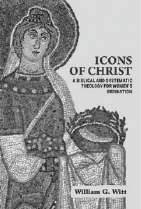Icons Of Christ: A Biblical And Systematic Theology For Women’s Ordination -- By: Robert W. Yarbrough
Journal: Eikon
Volume: EIKON 03:1 (Spring 2021)
Article: Icons Of Christ: A Biblical And Systematic Theology For Women’s Ordination
Author: Robert W. Yarbrough
Eikon 3.1 (Spring 2021) p. 154
Icons Of Christ: A Biblical And Systematic Theology For Women’s Ordination
REVIEWED BY
Robert W. Yarbrough (PhD, University of Aberdeen) is professor of New Testament at Covenant Theological Seminary and engages in theological education internationally. He is the author of The Salvation-Historical Fallacy? Reassessing the History of New Testament Theology, co-author (with Walter Elwell) of Engaging the New Testament, and author of five New Testament commentaries. His most recent book is Clash of Visions: Populism and Elitism in New Testament Theology.

William G. Witt. Icons of Christ: A Biblical and Systematic Theology for Women’s Ordination. Waco, TX: Baylor University Press, 2020.
The subtitle expresses the book’s main thrust: it makes a case for women’s ordination. “Icons” in the title signals the conviction developed by Karl Barth (348–49) that “there is no man or woman as such”; they are what they are only relationally. The New Testament’s understanding of Jesus Christ as the true image (eikōn) of God modifies Old Testament theological anthropology; both sexes “image Jesus Christ as disciples who are ‘in Christ’ — the image [icon] of God — as they are joined to the risen Christ through the presence of the indwelling Spirit” (341). Being Christian does away with gender distinctions for ministry purposes.
While reading this book, a reverie took me back to grad school. I had determined to specialize in New Testament studies. Excitedly I purchased an assigned textbook that promised to orient me in the history of this enterprise: The New Testament: The History of the Investigation of Its Problems by famed scholar Werner Georg Kümmel. Everything
Eikon 3.1 (Spring 2021) p. 155
prior to the German Enlightenment and its immediate precursors was viewed as pre-history. The real investigation of the New Testament started with Germans like J. S. Semler and J. D. Michaelis, David Friedrich Strauss and F. C. Baur. Significantly, what Semler and the others found in the Bible did not much resemble what all prior ages found. Only much later was I able to grasp how skewed was the view I received.
Icons of Christ is skewed in its starting point of declaring that all views on this topic “represent new theological developments in response to cultural changes of the last couple of centuries” (5, italics original). The author, William G. Witt (associate professor of systematic theology and ethics at Trinity School for Ministry, Ambridge, PA), sets forth four such views: (1) evangelical Protestan...
Click here to subscribe
